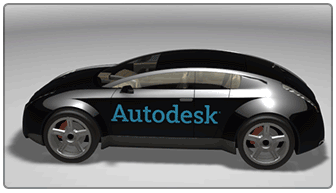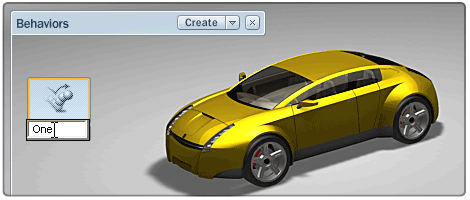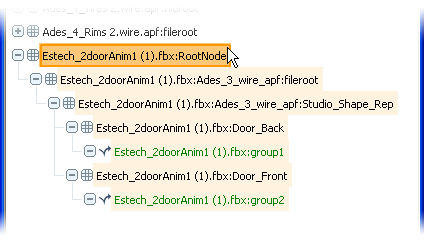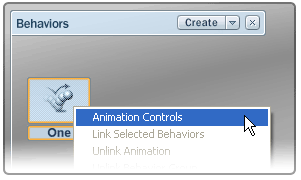Show in Contents

Add to Favorites

Home: Autodesk Showcase Help

triggers, 3D3D triggerspresentation mode, triggersclickable objectsAlternatives, triggerBehaviors, triggerEnvironments, triggerShots,
triggerslides, triggerSet 3D triggers in the scene

Add behaviors

Link multiple behaviors together

Import
an FBX Animation
This feature is available
only in Autodesk Showcase Professional.
Imported
FBX Animations are behaviors that apply complex keyframed animation
to objects in the scene. The FBX animation itself is created in
a separate application and imported into the scene with the behavior.
FBX Animation behaviors can be controlled individually, linked to
each other, and added to Storyboard slides to create a compelling
presentation.
NoteSave
a copy of your scene before creating or editing Imported FBX Animation
behaviors. The complex object transformations in FBX animations
are applied to objects outside of the normal Transformation Properties
and the undo list.
If
you pause an FBX animation and delete the behavior, your objects
will retain the animation transformations but cannot be reset to
their original locations. Always rewind or reset any animations
before saving or transforming objects.
Recommended FBX workflow
- Set up and optimize
the scene. Consider what objects will be animated and create appropriate
groups of multiple objects.
- Create alternatives and storyboard slides.
Some objects to be animated
may be part of alternatives, and animations can be triggered from
Storyboard slides.
- Select the objects to be animated by
a single behavior.
- Choose Select > Isolate Selected to
hide all other objects in the scene.
- Select File > Export as FBX... to
send the currently visible objects to an animation package for 3D
reference. For more information, see
Export As....
- Import the FBX into 3D animation software
as reference geometry.
NoteThe options available for FBX import will
vary based on the animation application used. Autodesk Maya and
Autodesk 3DStudio Max have robust and complete FBX support and are
recommended for this work.
- In the the animation software, animate
the imported reference geometry with node-based, rigid animation.
NoteSimple
keyframed transformations such as translate, rotate, and scale are
supported, as well as baked animations derived from Inverse Kinematics, Dynamics,
or other node-based animation methods.
Per-vertex and deformation animations are not supported.
- In the animation software, preview and
test the animation using the imported reference geometry and a seconds-based
timeline.
NoteNot
all scene animation needs to be created and exported at the same
time. Multiple animation behaviors can be created and each behavior
will have its own playback controls, but behaviors can be linked
to play concurrently or added to slides to create complex presentations.
In
the animation software, export the selected object animations as
FBX with the following conditions:
- Export Animation Only.
- Z-up World Coordinate Axis.
- Bake Complex Animations (if not already
baked)
The export dialog and supported features for
FBX export will vary between animation packages. The FBX export
dialog for Maya 2008 is shown below:
Import the FBX Animation
- Press B to show
the Behaviors interface.
- Click the arrow beside the Create button
and select Import FBX Animation.
- A file browser window opens. Browse to
and select the FBX file to use for the animation data.
NoteIt
is easiest to use the apply the FBX animation to the same geometry
exported earlier via FBX. This will insure that the node names and
structure match. If they match, the animation will automatically
be applied.
When
the FBX animation file is loaded, the Animation Properties window will
open.
- If you maintained the same hierarchy
and names in your scene and impotred FBX animation, a HUD message
will appear stating “Existing nodes were mapped to the created animation
behavior and some empty items were added to the scene. Press ‘O’ to view
them in the Organizer.”
- The animation is automatically applied
to matching nodes and can be previewed using the animation controls
in the Behavior Properties window.
Set animation properties
- Double-click over the name field of the new behavior
and type in its name. Or, double-click on the icon for the animation
behavior to rename it later.
This will help you identify the animation if
you create several animations.
- Set the Play Mode to either play Once and
stop, to Loop over and over, or to Oscillate back
and forth.
Re-parent objects if
needed
If the node structure
(hierarchy) of the imported FBX animation differs from the model
in the scene, you must manually re-parent the objects to be animated
beneath the new FBX nodes.
NoteIf
the same FBX is used for the imported geometry and the animation, the
node names will most likely match and the animation will be applied
automatically.
- Press O (or select Scene
> Organizer) to open the Organizer window.
- Browse to the bottom of the main organizer
arrangement.
- Locate and select the top-level nodes
that have the same name as the imported FBX file.
- In
the Organizer window, select List > Expand Everything Below to
show all nodes in that hierarchy.
The animated nodes of the FBX file are in green
text and have an animation icon next to them. (How you build your
animation file will determine how many nodes are animated.)
NoteThe name of each
animated node is preserved on import. Use these names to identify
which objects in the scene go with which animated nodes in the FBX
file.
- Select the objects you wish to animate
with the behavior.
- In the Organizer window, drag-and-drop
the object below the animated node to be used. Making the object
a child of the animated node allows the animation to control that
object.
NoteIf the Organizer
window is small, or the scene list is very long, drag the mouse
cursor over the “down arrow” at the bottom of the vertical scroll
bar to quickly go to the bottom of the list.
Play back the FBX animation
- In
the Animation Properties window, press the Playback
Controls button.
Or, right-click over the icon for the animation
behavior in the Behaviors interface, and choose Animation Controls
from the menu.
- This will open the Animation Controls
window.
NoteThe
title of the window will be the same as the behavior name. Multiple
behaviors can be played at the same time from multiple open Animation Control
windows.
- Press the Play button
to view the animation in the scene. Adjust the playback speed by
pressing the “+” and “-” buttons to
the right of the timeline scrub bar.
For details on all of the controls in the Playback
Controls window, see
Play the turntable animation
Add FBX Animations to Storyboards
Animations can be added
to Storyboard slides and triggered with different playback options
when the slide is played. See
Add behaviors to a slide for
more information. To learn more about Storyboards, see
Set up a storyboard.








